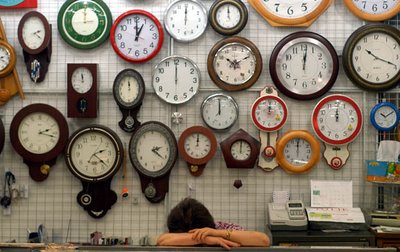
Alright, bad jokes aside, welcome back to SoKoNotes. Photographically speaking, it's been a big week and I have lots of photos to share.
People, people everywhere. The subways are always packed on Saturday afternoons. Shoppers, kids just let out of school, and couples walking hand-in-hand fill the stations. Periodically one sees a flash of brown skin or blond hair as a foreigner walks by, and the Russians are easy to spot because they are invariably a solid foot taller than everyone else. The whole mess of people surges and shifts as individuals travel in a thousand directions at once.
The focal point for most of these people is Seomyeon Station, the beating heart of Busan.

I always board the train at Nampo-dong, and by the time it reaches Seomyeon station, the subway car is like a sardine can. People get out of their seats and pack even tighter as the train pulls up to the platform. An equally huge crowd waiting to board the train flashes past the windows like the ranks of an opposing army; however, the pressure to get off the train usually outweighs the pressure to get on. The doors fly open and the passengers who want off the train surge past the passengers who want on the train. I usually catch a few unintentional kidney shots and my heels get battered up pretty bad as this transaction takes place. The sensation is akin to being moved by a strong river current.
I actually cited Seomyeon station as an analogy during Special class last Wednesday while discussing the random movement of molecules in a balloon. We have been focusing on matter and energy the last few weeks, and so I decided we should build air-powered rockets as a fun way to conclude the unit.
I bought clown balloons, straws, and colored paper and made an example rocket dubbed the ‘Ms. Huh’ by Ms. Ha. The students all built similar contraptions, but with varying degrees of decoration and balloon sizes.

One of our Korean teachers, Sook-hyun, is going to depart from ESS in a month. In celebration of her successful tenure at ESS, we took her to dinner at the usual Sumgyupsal restaurant. The teachers pulled all the stops. The table filled with food and drink. Mr. Yi ordered four bottles of soju and everyone (except Gavin and I) went to town. Even Soo-hee and Na-ri, rare drinkers both, had a shot or two. Gavin and I drank Makalli and beer, arguing that we should save the ethanol for cars considering how expensive gas is these days.

After dinner, we all went to a Norae-bong. I sang a couple of songs, Wonderwall and Bohemian Rhapsody, but no one was terribly interested in hearing English tunes, and that was just fine with Gavin and I, actually. Korean pop songs were the main dish, and just about everyone took a turn with the mic.
Eun-hee displayed a masterful command of the music, and as she sang, the other teachers clapped or kept time with tambourines. Every now and then, Mr. Yi, our company Chief Operating Officer, would stand to great fanfare and artfully sing solo, drawing even more applause and cheering from the teachers.

It was a really good time, and Gavin and I both had fun, though we were exhausted from a long day's work.
Nature is cranking up the thermostat these days, and the temperature hangs around a very pleasant 70 to 75 degrees. The days are getting longer and the angle of the sun at its zenith is getting steeper and steeper, creating hard, ultra-crisp highlights in the middle of the day.

I’ve stopped using my motorcycle to go to work, even though the good weather is awfully inviting. The bus, though much less fun and convenient, certainly presents more photo ops.


The possibility of being permanently paralyzed in a motorcycle accident looms over my head whenever I put on my helmet and crank up my steed. A lifetime of someone else wiping my ass is not worth fifteen minutes of convenience. Still, I can’t quite bring myself to sell the bike, as it opens up a lot more of Korea to exploration. Just this past weekend I packed a bag and rode to Gyeong-ju to see the famous Bulgeoksa temple.
I seriously underestimated the distance - which I pegged at fifty kilometers - and ended up driving 100 kilometers. The scenery was nothing to write home about. Actually, it felt a lot like driving through North Georgia.
Highway 35, which follows the valley floor between twin mountain ranges and parallels the interstate, is a strait shot from Busan to Gyeongju. Every few kilometers a small collection of gas stations, convenience stores and other road trip staples would pop up on the horizon, all festooned in big, garish billboards. I stopped periodically to stretch my legs and let the long, terrifying lines of speeding cement trucks get ahead of me.
Finally, I arrived in Gyeongju, which was deep in the thralls of spring. Fields spanning many square kilometers opened up before me filled with brilliant yellow flowers. People by the dozens parked their cars and frolicked in the flora.

It was impossible to escape the crowds.

If it hadn’t been for the motorcycle, my trip to Bulgeoksa from Gyeongju would have entailed an hour-long ride in a sweltering, packed bus. As I was parking my bike, I watched those sweaty, annoyed tourists pour out of those hot, cramped buses onto the hot concrete for the long walk up to the temple.
I started my walk cool and refreshed. Naturally, a small town comprised mostly of expensive hotels, restaurants and trinket shops had sprung up around the famous temple, and my route to the temple’s entrance forced me to walk this gauntlet of yelling, pushy shopkeepers.
‘Eat here, we have good food,’ one woman shouted at me. Gwen channayo, I responded. That’s OK. Even this basic command of Hangulmal, which most foreigners probably don’t exhibit, drew a faint gasp from the ajumma and she didn’t pester me any further as I continued up the hill.
I walked past a handful of overpriced-trinket shops. The trinket of choice seemed to be the classic round oriental umbrella. The vendors sold them in a variety of explosively loud colors, and I saw many Korean women with one over their shoulder.

Across a parking lot and up a flight of stairs and I was in the Bulgeoksa complex. Red brick paths lined in shin-high, wrought-iron decorative fencing wound away from me in all directions through a large grove of trees covered in new Spring leaves. The wind accompanied me along the path until it terminated in a road winding up towards the main gate.
Across the road the trees were still covered in pink flowers. People picnicked in the grass as tourists casually walked the street lined with dozens of hotdog and trinket vendors.
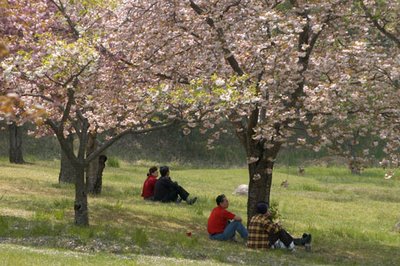

I paid four thousand for a ticket and proceeded inside the gate towards the main temple. A beautiful stone bridge with three arches crossed a shallow pond fed by a waterfall at one end. Carefree yellow, orange and white goi the size of medium-sized dogs swam languidly in and out of the shadows cast by the bridge, halfheartedly hunting for handouts from tourists crossing the the bridge above.
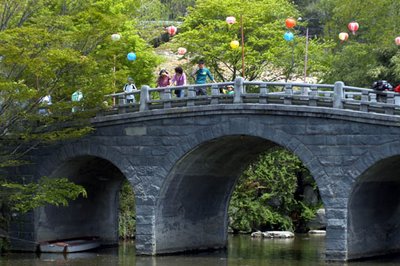
Once at the main temple, I ran into scores of people. The temple itself was in the process of being decorated for Buddha’s Birthday celebration to commence May 5th. Brightly-colored lanterns hung from electrical cords stretched from one end of the ancient structure to the other, breaking up the muted browns, grays and greens of the temple with their vibrant colors.
Buddhism has been a part of life in Gyeong-ju since Mahayana Buddhism was imported from China over the course of the 7th century. The center of Buddhist life in Gyeong-ju lies on Mount Namsan north of the city. The Buddhist monuments that have been excavated near or on Mount Namsan to the present include the ruins of 122 temples, 53 stone statues, 64 pagodas, and sixteen stone lanterns. Excavations have also revealed the remains of the pre-Buddhist natural and animistic cults of the region.
Some of Korea’s finest examples of Silla-era Buddhist engravings can be found on Mount Namsan; however, the biggest jewel in Gyeong-ju’s crown is Bugoksa Temple at the northern end of the mountain, where I stood. According to the temple’s own records, the current temple was built under King Gyeongdeok in 751 A.D. King Gyeongdeok’s prime minister wanted the temple built in order to calm the spirits of his ancestors.
Bulgeoksa took twenty-three years to complete. Thirty-three stairs lead into the temple, equivalent to the 33 steps to enlightenment. The most unusual feature of Bulguksa is the twin 8.2-meter stone pagodas. The first, Seokgatap, is over 13 centuries old. It’s twin, Dabotap, is 10.4 meters high and dedicated to the ‘many treasures’ described by Buddha in the Lotus Sutra



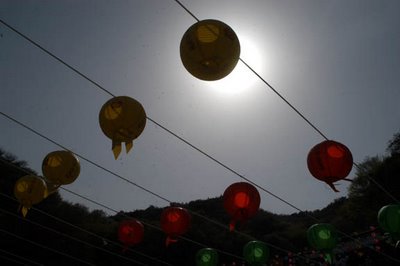
I soon tired of the crowds at the site, and after a few more stops at sites around Bulgeoksa, I mounted my bicycle to leave. On the way out of town, I passed a vacation resort, probably the home base for many of the people I had seen earlier in the day. A large river drainage culvert had been converted into a ‘Kart Track,’ where resort-goers could purchase an ATV and bring their computer games to life. There was only one problem. When you crash in the real world, there are real repercussions.
I was photographing this mother and her two daughters enjoying themselves when they rounded a corner too fast and lost control of the ATV. Overcome with its own inertia, the vehicle rode up on two wheels and haphazardly exited the turn. It slammed into the curb and the little girl in the middle tumbled off.
The ATV ran over and crushed her leg into two pieces, and she began to scream, a sound I will never forget. The woman, who was visibly dazed by the accident, fumbled around her screaming child, unsure of what was wrong. Another man and myself rushed over and heaved the ATV, woman and all, off of the girl.
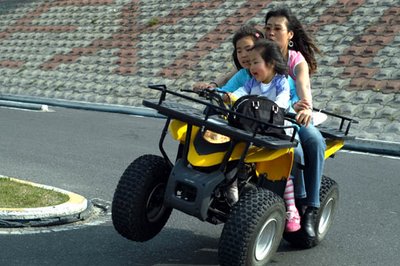
The girl scream louder and louder, whimpering between bursts. Her leg was crushed, the bone sticking through a gaping wound just above her ankle. Blood gushed down her leg as her father lifted her onto the back of the very vehicle that had run her over and rushed her to the hospital.
I was shaken by the accident. Earlier in the day I had also accidentally dropped my 800 dollar 80-200 f2.8 zoom lens, which would run 120 dollars to fix. The crowds, heat and duration of my travels had worn me down. It was time to go home.
The trip home, like the trip there, was perilous. Two hours on a motorcycle is hell enough, but two hours on a motorcycle in a land where traffic ‘laws’ are like some sort of national joke is pushing one’s luck.
People here tend to do all of their driving at the last minute. While on the four-lane highway on the outskirts of Busan, I watched a cab driver cut across five lanes of busy traffic - no turn signal or any warning whatsoever - in the space of fifty yards and then run the stoplight just ahead of oncoming traffic.
Was I surprised? No, not at all. Such behavior is commonplace, even among the buses and especially the motorcycle drivers. But as I said before, is the freedom of personal transportation worth a lifetime of paralysis? Probably not, and by the time I reached my apartment, I had pretty much convinced myself to put the bike up for sale. Now I’m not so sure, but probably another harrowing ride in the city will change my mind.
That’s all for now from SoKoNotes. I hope you enjoyed it. See you next week after Buddha’s birthday. Peace. --Notes
No comments:
Post a Comment